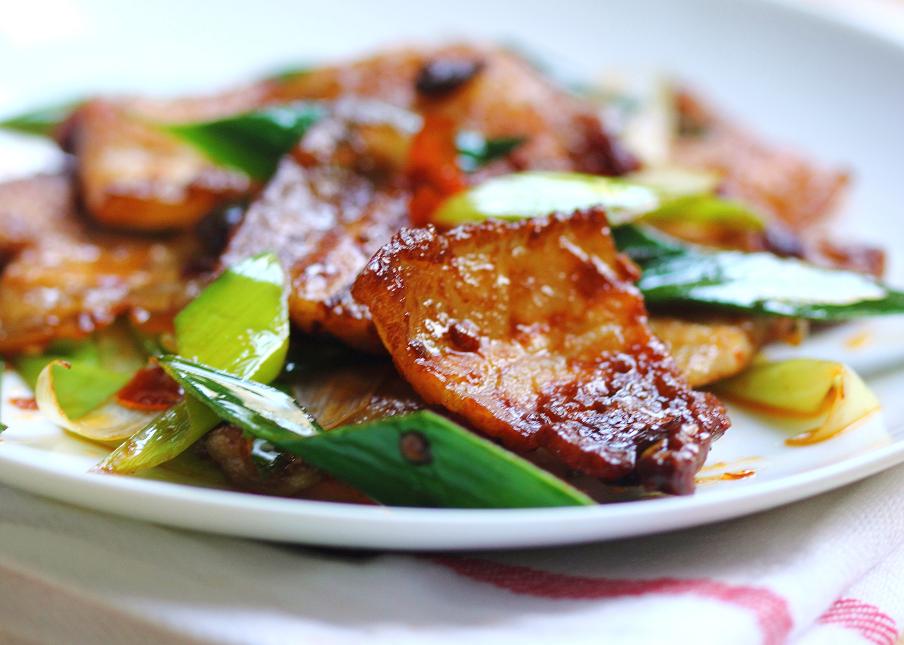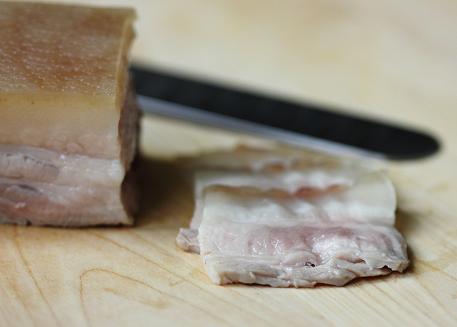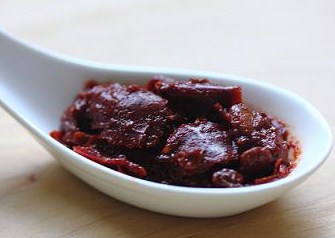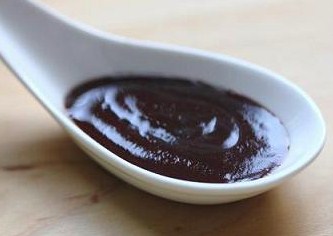Last Updated on November 28, 2020 by Simon Fan
Many people consider twice-cooked pork the number one dish of Sichuan cuisine. I wholeheartedly agree—it’s a remarkable dish on so many levels.
Start with the tender and succulent pork slices resulted from the twice-cooking process. Skin-on pork haunch or pork belly is first boiled or steamed, then cut into very thin slices, each containing skin, fat, and meat. During the second cooking process, the pork slices are stir-fried until they render some fat and slightly curl up resembling beautiful petals.
Equally intriguing is the sauce, co-starring dou ban jiang (豆瓣酱, chili paste with fermented fava beans) and tian mian jiang (甜面酱, sweet flour sauce). Together with soy sauce and sugar, they create a rich and perfectly balanced sauce that is savory, spicy, salty, and sweet.
The aromatic vegetables in the dish bring out the best flavors of the pork. In Sichuan, green garlic is traditionally used for the dish. Here in the US, you can find them at farmers’ markets during their short season in late spring and early summer. Outside the season, any of the vegetables from the lovely Allium family, especially baby leaks, would work well for the dish.
My recipe below uses the steaming method during the first cooking process. I think it preserves the pork’s flavor better than the boiling method. As for the pork, while pork haunch is the traditional choice, pork belly, more easily available and with more layers of fat and meat, is a better choice in my opinion.
Sichuan twice-cooked pork (四川回锅肉)
Serves 2
Ingredients
10 oz (285 g) skin-on pork belly
2 teaspoons tian mian jiang (甜面酱, see Notes below)
1 teaspoon soy sauce
1 teaspoon sugar
1 tablespoon vegetable oil
1 teaspoon Shaoxing wine
1 tablespoon dou ban jiang (豆瓣酱, see Notes below)
4 oz (115 g) baby leeks, white and tender green parts, cut diagonally into ¾-inch (2 cm) pieces
Directions
- Steam the pork until it’s almost cooked through, about 15 minutes. Cover the pork with plastic wrap and briefly chill it in the freezer (this will make slicing easier). Cut the pork crosswise into thin slices no thicker than ⅛ inch (3 mm). Ideally, you want each slice to be around 2½ x 2 inches (6 x 5 cm).
- Mix the tian mian jiang, soy sauce, and sugar in a small bowl.
- Place a wok or skillet over medium-high heat until hot, then swirl in the oil. When the oil starts to shimmer, add the pork and cook, stirring occasionally, until they’ve curled slightly, about 3 minutes. Splash in the wine and cook until the wine has evaporated, about 20 seconds. Next, add the dou ban jiang and stir-fry until the pork slices are coated with the paste, about 30 seconds. Add the tian mian jiang mixture and continue stirring and tossing for 30 seconds.
- Add the leeks and stir-fry until they’re crisp-tender, 1 to 2 minutes. Serve right away.
Notes: Dou ban jiang is a dark red-brown paste made from fermented fava beans, salt, flours, and various spices. The spicy version, the one I use for the recipe, also contains red chili peppers. Rich and complex in flavor, it’s a vital ingredient in Sichuan cuisine. Look for Pixian in the label, as the town of Pixian in Sichuan produces some of the best dou ban jiang in China.
Tian mian jiang is a dark brown fermented sauce made primarily from wheat flour, water, and salt. With a balanced sweet and salty flavor, it’s used frequently in Chinese dishes, especially those from northern China. The sauce for one of the most famous Chinese dishes, Peking duck, is made with tian mian jiang. If you cannot find tian mian jiang, hoisin sauce is an acceptable substitute, though keep in mind that hoisin sauce tends to be sweeter.






